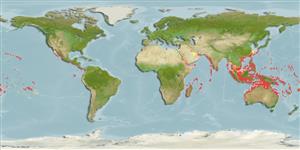Environment: milieu / climate zone / depth range / distribution range
Écologie
marin récifal; profondeur 1 - 73 m (Ref. 89467). Tropical; 30°N - 32°S
Indo-Pacific: East Africa south to Durban, South Africa (Ref. 4919) and east to the Panama, north to Ryukyu Islands, south to Lord Howe and Easter islands. Eastern Pacific: Guaymas, Mexico to Ecuador (Ref. 9349).
Taille / Poids / Âge
Maturity: Lm ? range ? - ? cm
Max length : 50.0 cm TL mâle / non sexé; (Ref. 9710)
Épines dorsales (Total) : 0; Rayons mous dorsaux (Total) : 10 - 12; Épines anales: 0; Rayons mous anaux: 11 - 13. Body covered with prickles (Ref. 559).
Occurs in coral-rich areas of clear lagoon and seaward reefs, Ref. 48637. Prefers oceanic localities (Ref. 48637). Solitary (Ref. 90102). Benthopelagic (Ref. 58302). Feeds mainly on tips of branching corals and to a lesser extent on sponges, mollusks, bryozoans, tunicates, forams, algae, and detritus.
Life cycle and mating behavior
Maturities | Reproduction | Spawnings | Egg(s) | Fecundities | Larves
Myers, R.F., 1991. Micronesian reef fishes. Second Ed. Coral Graphics, Barrigada, Guam. 298 p. (Ref. 1602)
Statut dans la liste rouge de l'IUCN (Ref. 130435)
Menace pour l'homme
Poisonous to eat (Ref. 4690)
Utilisations par l'homme
Pêcheries: commercial; Aquarium: Commercial
Outils
Articles particuliers
Télécharger en XML
Sources Internet
Estimates based on models
Preferred temperature (Ref.
123201): 24.3 - 29, mean 27.8 °C (based on 1320 cells).
Phylogenetic diversity index (Ref.
82804): PD
50 = 0.5000 [Uniqueness, from 0.5 = low to 2.0 = high].
Bayesian length-weight: a=0.03715 (0.01569 - 0.08798), b=2.87 (2.70 - 3.04), in cm total length, based on LWR estimates for this Genus-body shape (Ref.
93245).
Niveau trophique (Ref.
69278): 3.6 ±0.0 se; based on diet studies.
Résilience (Ref.
120179): Milieu, temps minimum de doublement de population : 1,4 à 4,4 années (Preliminary K or Fecundity.).
Fishing Vulnerability (Ref.
59153): Moderate vulnerability (40 of 100).
Nutrients (Ref.
124155): Calcium = 32.9 [13.7, 83.5] mg/100g; Iron = 0.547 [0.284, 1.225] mg/100g; Protein = 18.5 [16.3, 20.6] %; Omega3 = 0.113 [0.058, 0.212] g/100g; Selenium = 41.6 [21.7, 86.4] μg/100g; VitaminA = 42.6 [12.1, 150.8] μg/100g; Zinc = 0.875 [0.594, 1.307] mg/100g (wet weight);
